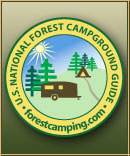Forest Information
The Francis Marion National Forest, located in South Carolina on the Atlantic coast, is comprised of 251,139 acres. There are seven developed campgrounds of which one meets the selection criteria.
During September 1989, the Francis Marion National Forest was hit dead-on by Hurricane Hugo. The effects of Hugo were widespread but, as time passes, the Forest has been recovering. Young Loblolly and Longleaf pines are growing up through acres of dead-and-down trees giving the Forest a bushy green appearance. The Forest's canoeing and fishing opportunities are back and super. Camping locations are as varied and delightful as in those pre-Hugo days. And the hiking is as good as ever. Francis Marion National Forest isn't as grand as some National Forests but it does feature the Southern characteristics of hospitality and resilience.
People visiting the historic communities of Charleston and Georgetown do not realize the Francis Marion National Forest is in between these old towns. Linking Charleston and Georgetown is U.S. Route 17 which parallels the Atlantic shoreline and passes right through Francis Marion. Only small signs welcome and bid visitors farewell to the Forest. But the dense stands of Loblolly and Longleaf pines are good indicators of the Forest boundaries.
A great deal of the wealth that established Charleston and Georgetown came from the land now called Francis Marion National Forest. Rice plantation profits built some of Charleston's magnificent old houses. Georgetown, South Carolina's third oldest city, was established in 1732 as an alternative port of entry to Charleston. Connecting these two communities is the Old Georgetown/King's Highway Road. In the Francis Marion, visitors can find the last 7 miles of this historic, tree-lined, single-lane, dirt roadway. This roadway was used by George Washington in 1791 for his Grand Tour of the original colonies. Later, plantation families took Georgetown Highway to reach their townhouses. Later still, soldiers, both from the North and South, marched along it. Listen carefully, visitors sometimes hear the rumble of an old farm wagon bringing fresh produce into town. Not only does Old Georgetown Road look magical, it is.
The stately live oaks, many surviving numerous hurricanes, along Old Georgetown Road and scattered throughout the Francis Marion, have witnessed a great deal of history. The small old village of McClellanville has some of the most magnificent examples of this resilient tree. These enormous trees, twisted trunks supporting wide-spreading limbs draped with Spanish moss, wave at passing visitors in true Southern hospitality. The Village Museum is located where the village and harbor meet. Here visitors learn about the area's history and special places. Near the Museum, the village's harbor is lined with fishing boats and a few pleasure crafts. Once a Summer retreat for rice plantation families, McClellanville is now a fishing village inviting visitors to enjoy its quiet charm.
A perfect base from which to explore the rich history and quiet charm of Charleston, McClellanville and Georgetown, is a sweet little campground named Buck Hall. Easy access, level parking aprons, hot showers, flush toilets, an RV dump station, and electric hook-ups make this a very popular recreational vehicle (RV) and motorhome camping location. However, one unique features of this little campground, its location is right on the Intracoastal Waterway, make this it attractive to car and tent camping enthusiasts. Imagine sitting at a campsite and watching a powerful speed boat, sleek luxury yacht, or battered fishing boat cruise by with its escort of seabirds.
Buck Hall campground is also a good base camp for those who want to explore the Francis Marion via miles of trails. There is the 1 mile long Batter Warren Interpretive Trail near Honey Hill featuring a Civil War earthen fort. Mountain bicyclist, ATV riders and dirt bike enthusiasts will enjoy the 40-mile Wambaw Cycle Trail that winds through some of Francis Marion's stands of hardwoods. Bird watchers and mountain bicyclist enjoy the various environments found on the 5-mile trail known as South Tibwin. Then, there are canoe trails such as the 8.2-mile Chicken Creek and the 14-mile Tuxbury Horse Trail. And that is just a few.
Then, there are the Sewee Visitor and Environmental Education Center, Sewee Shell Mound Interpretive Trail, and Cape Romain National Wildlife Refuge. Each is just a short distance from Buck Hall campground and offer a variety of hands-on oriented activities. With so much to do, Buck Hall campground should be considered for more then a weekend stay.
The Francis Marion National Forest was named for the Revolutionary War hero nicknamed "Swamp Fox." Outwitting the British at every opportunity, Francis Marion (a.k.a., Swamp Fox) demonstrated a resiliency and toughness characterized by the Forest that carries his name. Come on down to see, explore and enjoy the old haunts of that irrepressible rascal, the Swamp Fox, in the Francis Marion National Forest.
ADDRESSES
SUPERVISOR ADDRESS
4931 Broad River Rd.
Columbia, South Carolina 29210
803-561-4000
RANGER DISTRICT ADDRESSES
Andrew Pickens
112 Andrew Pickens Circle
Mountain Rest, South Carolina 29664
864-638-9568
Enoree
20 Work Center Rd.
Whitmire, South Carolina 29178
803-276-4810
Francis Marion
2967 Steed Creek Rd.
Huger, South Carolina 29450
843-887-2200
Long Cane
P.O. Box 588
Edgefield, South Carolina 29824
803-624-9471
|
